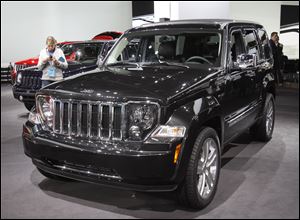
Car sales down in May; Chrysler shows boost
6/1/2011
Sales of the Jeep Liberty climbed 47 percent from a year ago to 6,048 vehicles.
DETROIT — U.S. auto sales cooled off in May as dealers started running short on some popular, fuel-efficient models and buyers were turned off by sharply lower incentives.
Deals aren’t likely to come back until the end of this summer. Some experts are advising people to delay their purchases if they can.
“If you don’t have to buy, wait until fall. If you lease a car, extend it,” said Edmunds.com chief Jeremy Anwyl.
Toyota Motor Corp., Honda Motor Co., and Nissan Motor Co., all of which ran short of models because of parts shortages caused by the March 11 earthquake in Japan, had the biggest sales declines, with Toyota down 33 percent, Honda off 23 percent, and Nissan off 9 percent compared with May of last year.
General Motors Co. sales dropped 1.2 percent, as falling pickup truck sales offset strong sales of more fuel-efficient cars and crossovers. It was the same story at Ford Motor Co., which saw sales fall 2.4 percent for the month. Pickup sales dropped more than 10 percent at both companies.
At Chrysler Group LLC, however, sales last month jumped 10 percent, bouyed by various Jeep brand vehicle sales as well as its Fiat 500.
Sales of Toledo-made Chrysler sport-utility vehicles were up. Sales of the Jeep Liberty climbed 47 percent from a year ago to 6,048 vehicles, Jeep Wrangler grew 4 percent to 10,008 units, and the Dodge Nitro increased 7 percent to 1,900 units. For the year, sales of the Liberty are up 42 percent, Wrangler up 13 percent, and Nitro up 35 percent.
Once again, small, compact and midsize car sales were up and truck sales were down because of high gas prices.
At Ford, where the F-Series pickup is traditionally the top-selling vehicle in the U.S., fuel economy clearly was driving sales. For the first time in decades, the company sold more F-150s with V6 engines (55 percent) than it did with larger V8s.
Despite a raft of bad economic data in the past few days, automakers generally said they were still optimistic for the year, with Ford and GM sticking with annual forecasts of around 13 million in U.S. sales. That’s far short of the 2000 peak of 17.3 million, but better than the 10.4 million trough in 2009.
Automakers usually use the warmer months to cut deals and clear out old inventory to make way for new models in the fall. But this year, they don’t have many of last year’s models sitting around. Japanese automakers had to cut production after the earthquake and domestic automakers can’t produce cars any faster. Automakers are also raising prices to make up for the higher price of steel and other commodities.
The car companies offered their lowest incentives in six years last month, according to Edmunds, spending an average of $2,094 per vehicle on sweeteners such as rebates and low-interest loans. That’s flat from April and nearly 20 percent lower than in May of 2010. Prices on Japanese cars have risen an average of $610 per vehicle since the quake, Edmunds said.
Shortages are the biggest reason. IHS Automotive estimates that the U.S. has around 400,000 fewer cars in inventory than it should have at the current sales pace. Toyota began May with only enough Prius hybrids for 10 days of sales. A 60-day supply is considered healthy.
As a result, the Prius, which is made in Japan, is now selling for 2 percent above the manufacturer’s suggested retail price of $23,250, a $5,000 premium, according to Kelley Blue Book. Prior to the quake, it was selling for 1 to 2 percent below that price.
Even sales of some fuel-efficient small cars not affected by the earthquake are in tight supply. GM said it only has a 37-day supply of the Chevrolet Cruze small car.